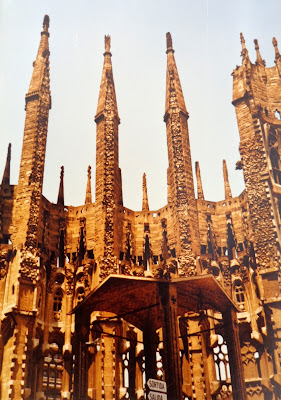Blog 25
When I wrote last week’s
blog about Antoni Gaudí, I started thinking about the artists that
have influenced me with regard to my painting style. A couple of
names came to my mind, not all of them were famous artists. Some
influences were more obvious than others.
All of my teachers have
influenced me, along with my painting buddies. Being with them on
painting trips and seeing first hand how they work certainly has an
effect on my painting style. The agreement on a painting location can
create a mutual influence. We look for a place that excites all of
us. Sometimes, a choice might suddenly provide an image you would
have missed on your own. I enjoy looking at the focus each of us
picked for their painting. Sometimes, the the similarities are
astonishing, other times everyone picked a different part of the
scene in front of us. While witnessing each other’s struggles and
successes as well as during the day’s reflection, you get new ideas
and insights.
There are many examples in
art history where painters have influenced each other to help each
other grow. However, I don’t want to talk about my contemporaries
today but about the masters who have inspired me. I have already
mentioned Frida Kahlo and Emily Carr in one of my May posts. This
time I am looking at the four other painters who have inspired me.
 |
| Waterlilies, acrylic on canvas, 18" x 24" |
First of all there is
Claude Monet. I love the light and colours in his paintings. I admire
that he painted the same subject over and over again to study the
change in appearance at different times of the day and season. This
is something that fascinates me whenever we return to Kamouraska. No
matter how often I paint a certain scene, it always looks different
due to the quickly changing light and the tides.
However, when I took a
workshop on his way of painting, I realized that I did not enjoy his
technique at all. I gained immense respect for his use of small,
thin, yet visible brush strokes which give the illusion of movement,
but had a hard time staying patient while using the short brush
strokes. It was hard to put the colours next to each other without
blending them.
 |
| Ottawa Valley, acrylic, 16|" x 20" |
Then there is Vincent van
Gogh. I just love his bright colours and the wild movement in his
paintings. His strong brushstrokes let you feel the energy and
passion van Gogh put into his paintings.You can feel the urge he had
to express himself through his art. This is an energy I would like to
put into my paintings because this energy is what the viewer feels
when he looks at the finished painting.
 |
| The Front, acrylic on canvas, 22" x 28" |
When I was introduced to
Joseph Mallord William Turner, the “painter of light”, I was
captivated by the luminosity of his skies. Since then the design of
my skies became very important to me. I particularly enjoy his
technique of painting layers over layers with very loose brush
strokes creating lots of movement. His technique is especially useful
whenever I only have short periods of painting time
 |
| The Red Tree, acrylic on board, 8" x 10" |
Last but not least, there
is Tom Thomson. When I paint outside with my painting buddy Janis, it
takes me a lot longer than her to capture a scene. This is due to our
different temperaments and painting styles. What I learned during a
Tom Thomson workshop is that he used his time on site to capture the
essence of the scene with quick thick
strokes. He did not aim
for a finished painting. If he liked a certain scene, he went back to
his studio and painted it on a larger canvas. This was a big
revelation for me, one I have to remember constantly. It is easy to
forget sticking to the essence when you are confronted with an
overload of impressions. I love the energy that is captured
especially in his sketches with the help of bright colours, and thick
brush strokes which express movement.
Even though the four
painters have different painting styles, they all managed
successfully to capture the essence of a scene and the energy of the
moment. They completely immersed themselves in the process of
painting so that you can feel the physical sensation they felt when
they painted their pieces. This is something I aim for: to be fully
in the moment, to simplify a scene to keep the focus on the things
that are important. An image is so much more powerful when you keep
the big picture in mind by eliminating the small and unimportant
stuff.
I am always open to learn
something new. Incorporating new techniques or materials into my art
helps me to grow and hopefully keeps my art from growing stale. It is
a life-long process and I am excited about new possibilities and
challenges.
If you enjoyed this blog
and would like to get more information about my art, I encourage you
to sign up to my monthly newsletter on my website
www.KerstinPeters.ca.
The newsletter is published on the last Wednesday of every month.
When subscribing, you will automatically receive my free eBook “I
Am Ready To Paint But Where Do I Start?”.
If you know someone who
might also like to read my blog, please share it. Thank you in
advance for helping me to reach a bigger audience.







